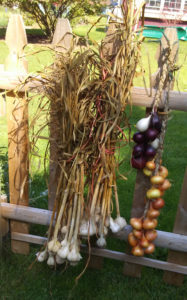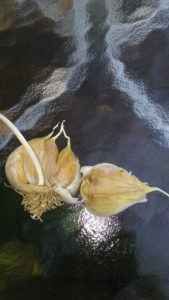The Village Gardener: Garlic and Herbs in the fall garden
by Georgeanne Vyverberg –

I like to say “a day without garlic is like a day without sunshine.” Silly but almost true. I’ve been growing the “stinky rose” for over 40 years and can’t imagine a growing season without it. For a few years after selling my country home I borrowed spaces in friend’s gardens, so I could keep my favorite variety, German White seed, alive. I am a bit fond of it and can’t imagine many meals without it.
Garlic (Alium sativa}, which is native to Central Asia has been grown for thousands of years for food and medicine. When chopped cut or crushed, the sulfur compound allium is released. It’s been a very popular remedy for avoiding and alleviating the common cold. There is some evidence it also aids in reducing high blood pressure and Cholesterol. The ancient Greeks are said to have used it as a performance enhancing drug!
Garlic is also one of the easiest crops to grow. Seed is available on line, but its rather expensive. In late summer and early fall begin searching the farmers markets and talk to the grower. Ask him or her what their favorite variety is and why. There are so many varieties available, but pick healthy looking bulbs that are free of any mold and have large cloves. Also, there are “soft neck” varieties, which are great for braiding and “hard neck” varieties that are not. Both have a wide range of flavors and sweetness and spiciness.

Since garlic is in the ground for 9-10 months it needs really nutrient rich soil. Soil amended with organic compost is best and most backyard gardens have that richness. Garlic is best planted early to late October although I have planted it in November and once in December. First break up the bulbs into cloves and choosing the largest cloves plant them 4 inches deep and a good 5 inches apart. Plant the flat end down with the pointy one up. If you don’t the garlic will grow, but be misshaped because It turns upward toward light. This helps to insure large cloves. Each clove becomes another bulb. That’s about it. I usually wait till November or at least until it’s pretty cold and then mulch heavily with straw or old hay. The mulch helps to protect the cloves, which are actually beginning to slowly grow, from being frost heaved out of the soil. Garlic is typically harvested in mid-July when at least three to four leaves begin to brown. If left too long the bulbs will begin to separate and won’t store for very long. Hang to dry and store in a cool dry place..never the refrigerator where they will mold.
Just a short suggestion here: It’s a good time to pot up some of those herbs you have been growing all summer, and find a sunny window sill where you can continue to enjoy them all winter. About the only one that dislikes being transplanted is parsley, because of its long taproot, but I have found that it winters over easily in the garden especially if you place a bushel basket over it. It’s amazing how fresh it remains out there.